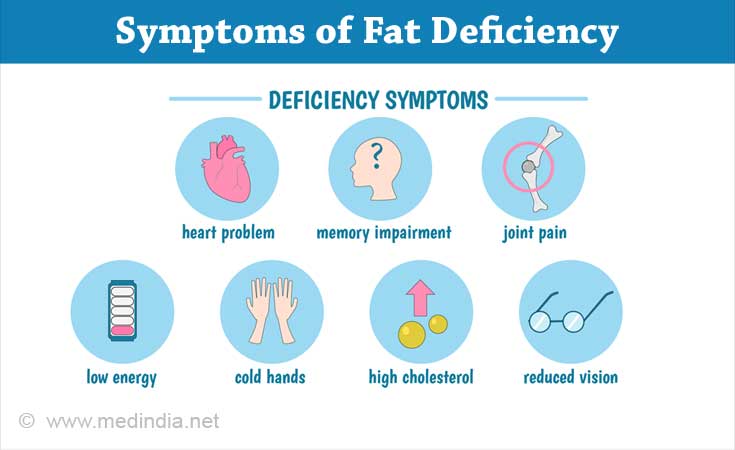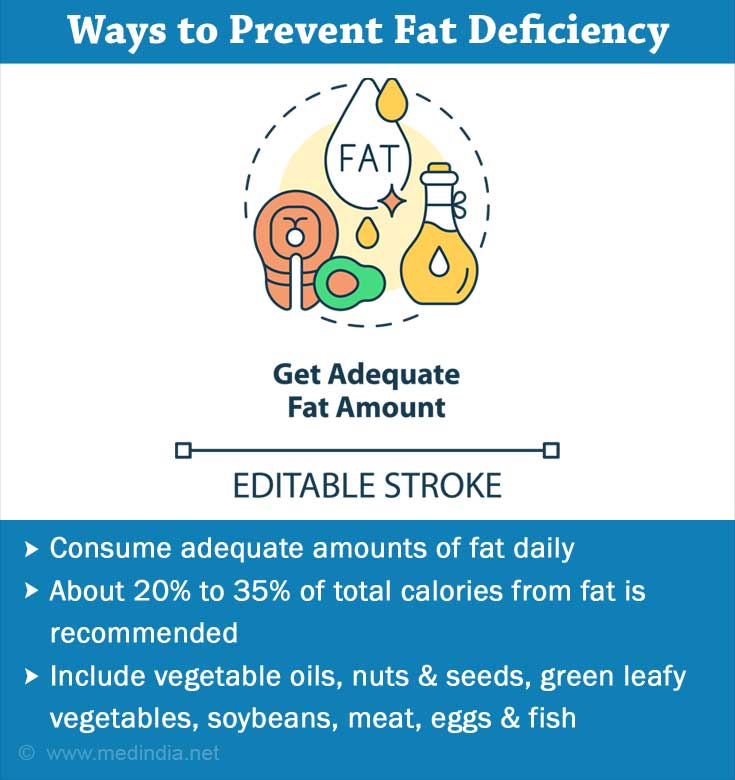- Essential Fatty Acid Deficiency - (https://med.virginia.edu/ginutrition/wp-content/uploads/sites/199/2014/06/Parrish-
June-17.pdf) - Field, C. J., & Robinson, L. (2019). Dietary Fats.Advances in Nutrition (Bethesda, Md.),
10(4), 722-724 - (https://doi.org/10.1093/advances/nmz052) - Fat: The Facts - (https://www.nhs.uk/live-well/eat-well/different-fats-nutrition/)
- Essential Fatty Acids - (https://lpi.oregonstate.edu/mic/other-nutrients/essential-fatty-acids)
- Richardson, Alex & Ross, Marion. (2003). Physical Signs of Fatty Acid Deficiency. - (https://lpi.oregonstate.edu/mic/other-nutrients/essential-fatty-acids)
- Siguel, E. (1998). Diagnosing essential fatty acid deficiency.Circulation,97(25), 2580-2583. - (https://lpi.oregonstate.edu/mic/other-nutrients/essential-fatty-acids)
- Messamore, E., & McNamara, R.K. (2016). Detection and treatment of omega-3 fatty acid deficiency in psychiatric practice: Rationale and implementation. Lipids in Health and Disease, 15,25 - (https://doi.org/10.1186/s12944-016-0196-5)
- Bird, J. K., Calder, P. C., & Eggersdorfer, M. (2018). The role ofn-3 long chain polyunsaturated fatty acids in cardiovascular disease prevention, and interactions with statins. Nutrients, 10(6), 77 - (https://doi.org/10.3390/nu10060775)
- Lange, K. W. (2020). Omega-3 fatty acids and mental health.Global Health Journal,4(1), 18-30 - (https://doi.org/10.1016/j.glohj.2020.01.004)
- Yang, M., Zhou, M., & Song, L. (2020). A review of fatty acids influencing skin condition.Journal of Cosmetic Dermatology,19(12), 3199-320 - (https://doi.org/10.1111/jocd.13616)
- Essential Fatty Acids and Skin Health - (https://lpi.oregonstate.edu/mic/health-disease/skin-health/essential-fatty-acids)
- About Essential fatty acid deficiency - (https://lpi.oregonstate.edu/mic/other-nutrients/essential-fatty-acids#deficiency)
What is Fat Deficiency?
Fat is an essential macronutrient in the diet that heroes several crucial functions in the body, such as facilitating the absorption of fat-soluble vitamins, providing energy, cushioning organs with fat stores, and providing insulation. Although high intake of fats has recorded several health diseases, its deficiency is also harmful. Fat deficiency leads to skin disorders, neurological dysfunction, retarded growth, hair loss, and many more.
Consuming adequate amounts will divert oneself from fat deficiency diseases.
What are the Causes of Fat Deficiency?
Dietary fats are the major source of essential fatty acids (EFA) that the body cannot synthesize. A severely fat-restricted diet is a widely seen causative factor. Also, impairment in the consumption, digestion, absorption, and/or metabolism of fat may lead to deficiency.
Gastrointestinal disorders like inflammatory bowel disease, resection of the bowel, celiac disease, and pancreatic insufficiency to produce enzymes are also potential causative factors. Some surgeries can also lead to deficiency like bariatric surgery that can cause malabsorption.
What are the Symptoms and Signs of Fat Deficiency?
Fat deficiency symptoms and physical signs are:

- Loss and de-pigmentation of hair
- Dry skin, scaly rashes
- Brittle nails
- Poor healing of wounds and risk for infection
- Retarded growth among children and loss in weight gain
- Increased risk for mental disorders
- Visual symptoms like difficulty in reading and poor vision during the night
- Shoot up in omega-9 fatty acids and decrease in omega-6 fatty acids in the tissues
- Impaired cholesterol transport
- Decrease in myocardial contractility
How do you Diagnose Fat Deficiency?
The signs and symptoms exhibited are the major tools to spot deficiency. Some biochemical markers are used for diagnosis. Diminished levels of linoleic acid and alpha-linolenic acid may indicate fatty acid deficiency. Eicosatrienoic acid: arachidonic acid (triene:tetraene) ratio is indicative of fat deficiency. The reduced availability of alpha-linolenic acid and linoleic acid results in elevated oleic acid, which is metabolized to eicosatrienoic acid. Hence, a ratio of more than 0.2 (some suggest >0.4) diagnoses essential fatty acid deficiency. Elevation in this ratio can occur even before the onset of clinical manifestations. Alterations in platelet aggregation and liver function tests have been identified in patients deficient in EFA.
What are the Fat Deficiency Diseases?
Deficiency of fats may accelerate several health problems and fat deficiency diseases, most of which with supplementation of the essential fat can be treated or managed. Fat deficiency effects are seen in lipid profile, skin, mental, and heart health.

Skin Disease: Fatty acids play indispensable roles in skin functions. Deficiency in EFA will first affect the epidermal tissues. The skin barrier function is also affected by a deficiency of fat. Individuals with compromised immunity and deficient in fat are prone to psoriasis. Lack of fat will pave the way to dermatitis, hyperproliferation of epidermis, and transepidermal water loss.
Multiple Sclerosis (MS): MS may result in omega-6 deficiency. Providing 19 to 23g of additional omega-6 fatty acids has shown to be fruitful in reducing the risk for disability.
Mental Disorders: Diets low in polyunsaturated fatty acids have been revealed to affect mental health. Individuals with autism spectrum disorder are found to have low levels of PUFA (omega-3 fats) and findings suggest that supplementation may aid in managing the symptoms. Although, more studies are needed to conclude on supplementation.
Major depressive disorders have been associated with lower concentrations of omega-3 fatty acids. Postpartum depression in mothers could be due to poor dietary intake of fats. Deficiency may also pose a risk for schizophrenia, characterized by cognitive decline, delusions, and social isolation. The deficiency of docosahexaenoic acid (DHA) and eicosapentaenoic acid (EPA) in the brain cells of people with schizophrenia was observed. A decrease in plasma concentrations of PUFAs (omega-3 fats) may augment the risk for Alzheimer’s disease.
Dyslipidemia: Cholesterol levels may be altered due to essential fatty acids deficiency. Deficiency induced the activity of the HMG CoA reductase, and thus, increased cholesterol synthesis was observed. Treating the deficiency retarded the activity of the enzyme.
Heart Disease: The EPA and DHA content in the red blood cell membranes (omega-3 index) are correlated with the risk of heart disease. Observational studies have revealed that low content of EPA and DHA increased the risk for coronary heart disease. An omega-3 index of less than 4% is a high risk for cardiovascular disease.
How can you Treat Fat Deficiency?
Supplementation is a valuable tool in treating deficiency. Studies observed fruitful results in mental disorders with supplementation. For patients with major depressive disorder supplementing EPA and DHA at a dosage of 1g per day is recommended. A few other studies found supplementing EPA and DHA to be efficacious in treating mood symptoms. Research has also depicted that higher doses of EPA to DHA are beneficial in treating attention deficit hyperactivity disorder (ADHD) symptoms and depression.
Individuals who have eating disorders or are following diets extremely low in fat should be encouraged to consume adequate fats from the diet. Including good fats like vegetable oils, nuts, and nut butters should be advised to treat essential fatty acid deficiency.
Lipid injectable emulsion can also be considered in the treatment. The use of topical oils has been shown by a few studies to be beneficial in improving deficiency markers. The majority of the symptoms of EFA deficiency are reversible when adequate EFAs are provided.
How to Prevent Fat Deficiency?

Fat deficiency can be kept at bay with adequate fat consumption. Consuming the right type and amount of fats from the diet is the best prevention strategy. People at risk for deficiency should be educated on adequate intake. A healthy diet comprising 20% to 35% of total calories from fat is recommended. A minimum of 10% of total calories should comprise polyunsaturated fats and about 2% to 4% of total calories of linoleic acid.






